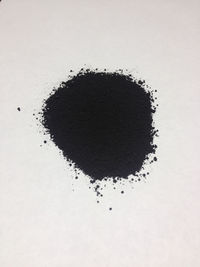Copper(II) oxide

| |
| Names | |
|---|---|
| IUPAC name
Copper(II) oxide
| |
| Other names
Copper brown
Copper monoxide Cupric oxide | |
| Properties | |
| CuO | |
| Molar mass | 79.545 g/mol |
| Appearance | Black solid |
| Odor | Odorless |
| Density | 6.315 g/cm3 |
| Melting point | 1,326 °C (2,419 °F; 1,599 K) |
| Boiling point | 2,000 °C (3,630 °F; 2,270 K) (decomposes) |
| Insoluble | |
| Solubility | Reacts with acids Soluble in aq. ammonia, KCN, NH4Cl Insoluble in organic solvents |
| Vapor pressure | ~0 mmHg |
| Thermochemistry | |
| Std molar
entropy (S |
43 J·mol−1·K−1 |
| Std enthalpy of
formation (ΔfH |
−156 kJ/mol |
| Hazards | |
| Safety data sheet | Sigma-Aldrich |
| Flash point | Non-flammable |
| Related compounds | |
| Related compounds
|
Copper(I) oxide |
| Except where otherwise noted, data are given for materials in their standard state (at 25 °C [77 °F], 100 kPa). | |
| Infobox references | |
Copper(II) oxide or cupric oxide (formula CuO) is a high oxide of copper. It is a black material that often coats old pieces of copper, most commonly found in pure form as a powder.
Contents
[hide]Properties
Physical
Copper(II) oxide is a black colored, ionic oxide. It is formed by oxidation of copper metal either with a chemical oxidizer, by heating in atmospheric oxygen or by electrochemical oxidation using copper as a anode. cupric oxide can be converted back to copper metal by carbothermal reduction, in which it is reduced by carbon under strong heat.
Chemical
Most acids will dissolve copper(II) oxide to give their corresponding copper(II) salts.
Availability
Copper(II) oxide is most commonly used for coloring materials such as cloth and ceramic due to its deep black color. Therefore, it can be bought from pottery supply stores.
Preparation
Copper salts can be precipitated with either a carbonate or hydroxide to form either copper(II) carbonate or copper(II) hydroxide. These salts can be heated to from copper(II) oxide.
Copper oxide can also be produced from electrolysis using a copper anode and a dilute solution of hydroxide dissolved in water. This product should be heated at over 200°C to decompose hydroxide impurities.[1]
Projects
- Explosive thermite
- Flash powder
- Producing the energetic bis(ethylenediamine)copper(II) perchlorate
- Producing other copper salts
Handling
Safety
Copper(II) oxide is an irritant, so avoid handling it directly. Since it is insoluble, it can be disposed of as toxic waste without alteration. It will also stain many materials, though it's relative easy to clean, by dissolving it in a weak acid, such as acetic acid.
Storage
Copper(II) oxide should be stored in closed bottles, away from moisture and acidic vapors.
Disposal
As it is toxic, copper oxide should be reduced to copper metal and recycled.